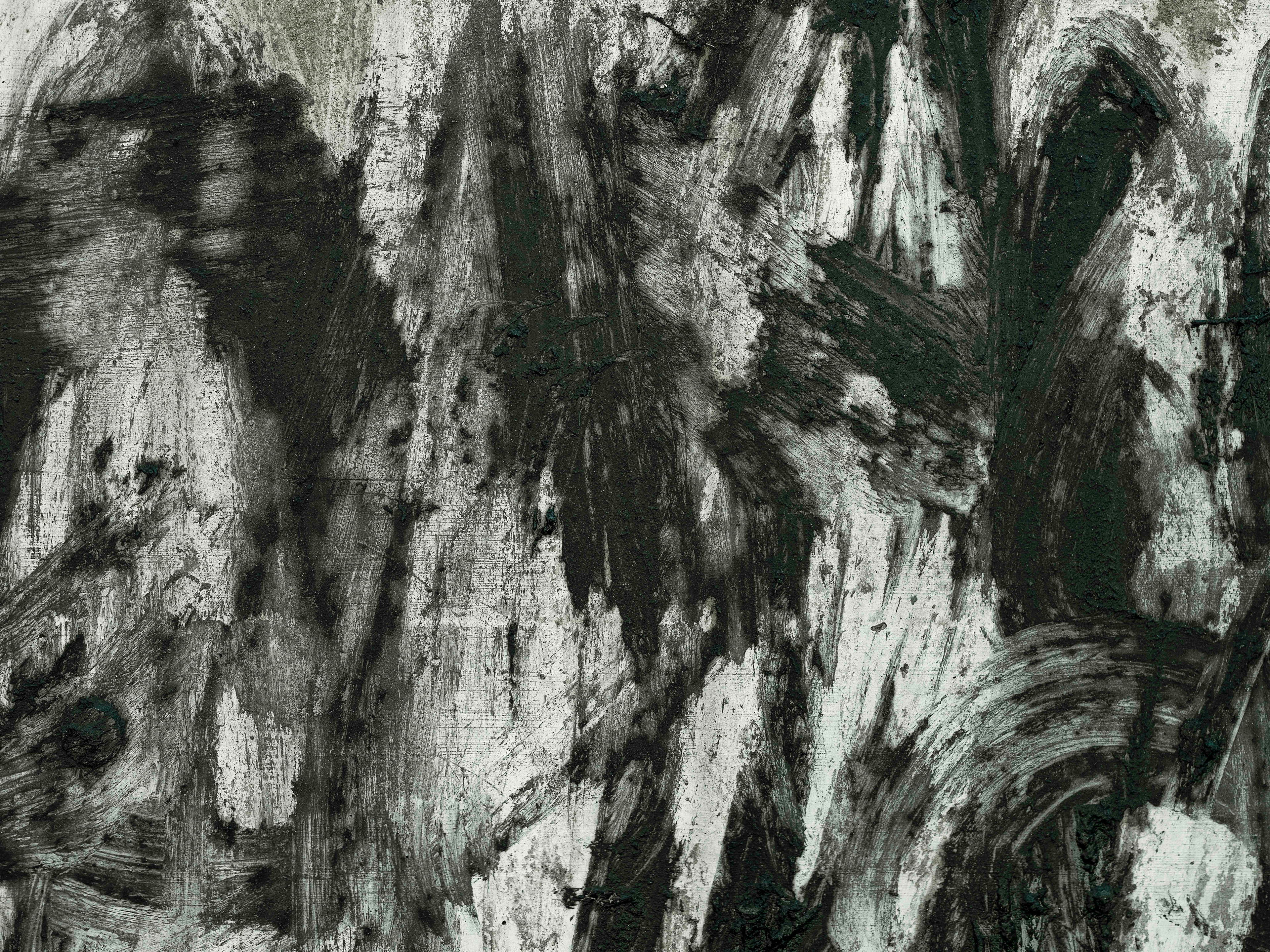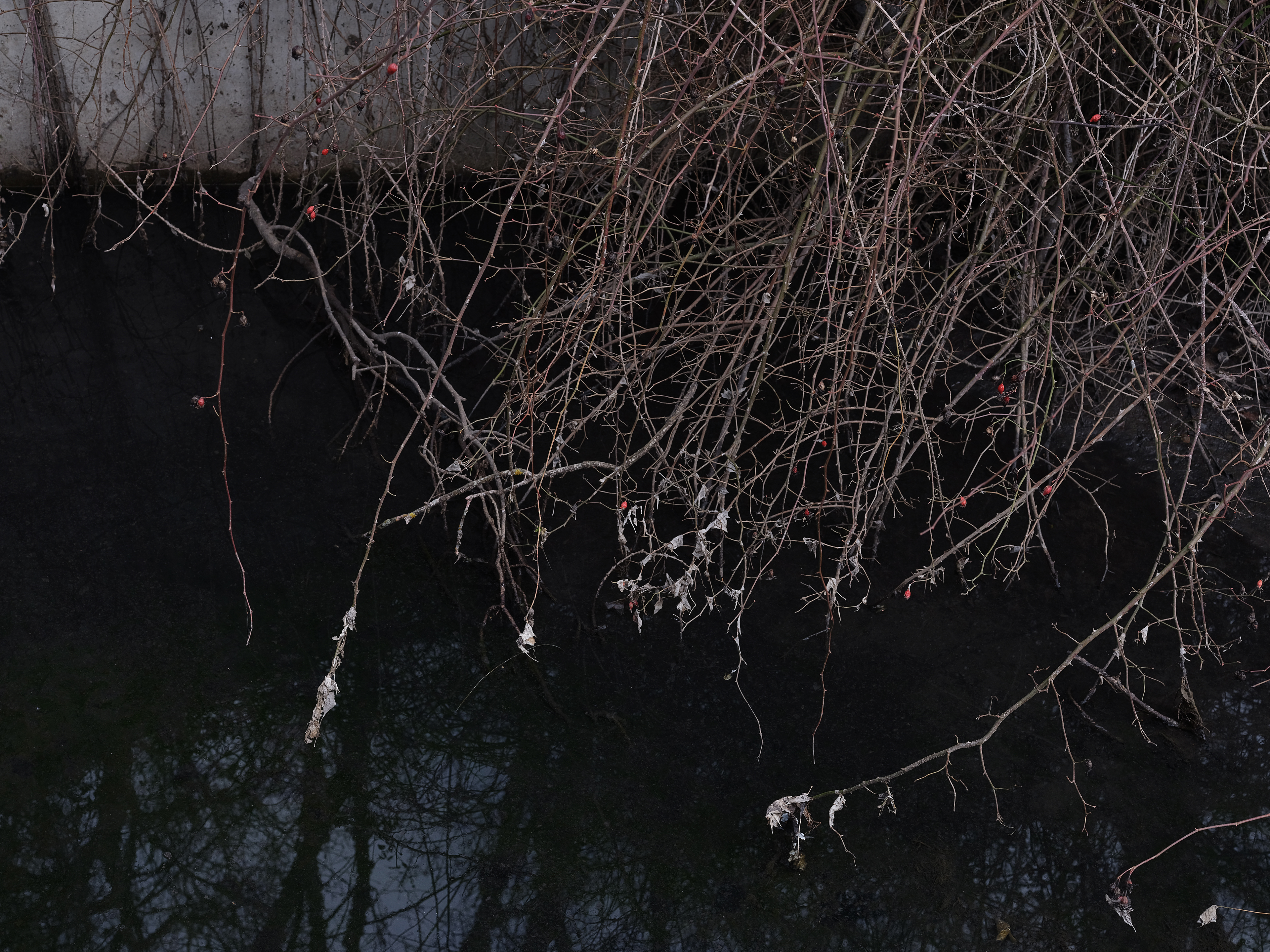













"Me siento y te espero.
Arsénico.
Llegas tarde mientras la lengua del mejillón ya no filtra tu saliva.
Aluminio.
Ahora bebes agua sin respirar y huele a Bario. Lo quieres.
Tu color de río llora, no puede.
¿Rojo?¿Negro?¿Blanco?¿Verde?¿Rosa?
Bismuto.
Dicen que tus besos tienen sabor metal en los restos de tu boca.
Cadmio.
Quieres un abrazo pero los brazos no llegan mientras tu tripa se hincha con el destello del metal en mis pies.
Cromo.
Y te preguntas dónde estoy, íntimo, pero me expulsas.
Cobre.
Recuerdas el sueño y me lo cuentas cada vez que me hundo en tu líquido que inunda la casa mientras tus párpados pesan pero sabes que es un sueño.
Hierro.
Qué bella coreografía cuando el viento acaricia las ramas que se hunden en tu barro y no se van.
Una flor de zarzamora. Enamoras.
Manganeso.
Vomitas en tu pecho pero la calle no lo sabe. Te escondes. No te escuchan, lo sabes.
¿Qué? Mercurio.
¿Qué? Mercurio.
¿Qué? Mercurio.
Tienes sed y dibujas tu figura con dolor por no saber por qué.
Niquel.
Te piso y no gritas. No te escucho, lo sabes.
Plomo.
Tu cuerpo ya no es el mismo.
Vanadio.
No te escuchan, lo sabes.
Zinc.
Mutación, tu vía de escape."
[Poema para el río Aulencia, 2025]
"I sit and wait for you.
Arsenic.
You are late while the mussel's tongue no longer filters your saliva.
Aluminium.
Now you drink water without breathing and it smells like Barium. You want it.
Your river colour cries, it can't.
Red? Black? White? Green? Pink?
Bismuth.
They say your kisses taste like metal in the remains of your mouth.
Cadmium.
You want a hug, but my arms can't reach you while your stomach swells with the sparkle of metal on my feet.
Chromium.
And you wonder where I am, intimate, but you push me away.
Copper.
You remember the dream and tell me about it every time I sink into your liquid that floods the house while your eyelids are heavy, but you know it's a dream.
Iron.
What beautiful choreography when the wind caresses the branches that sink into your mud and don't go away.
A blackberry flower. You make me fall in love.
Manganese.
You vomit on your chest, but the street doesn't know. You hide. They don't hear you, you know that.
What? Mercury.
What? Mercury.
What? Mercury.
You are thirsty and you draw your figure with pain because you don't know why.
Nickel.
I step on you and you don't scream. I don't hear you, you know that.
Lead.
Your body is no longer the same.
Vanadium.
They don't hear you, you know that.
Zinc.
Mutation, your way of escape."
[Poem for the River Aulencia, 2025]
[ESP]
Fuga Color Mutante (2022 / 2025)
“Fuga Color Mutante” es una oda a la mutabilidad de la materia en los espacios naturales contaminados.
La obra recoge la evidencia de un vertido actual contaminante al río Aulencia en la vertiente sur de la sierra de Guadarrama de Madrid. Este suceso se produce dentro de la zona del primer desagüe de la depuradora del embalse de Valmayor al río, cuyo objetivo es dotar de agua potable a la Comunidad de Madrid.
Siguiendo el cauce del río, se estudia su cieno, mezclado con un vertido de metales pesados que provocan la creación de colores que mutan y cambian su forma dentro del agua.
En la investigación de este proyecto, se estudia el agua del río Aulencia, afluente del río Guadarrama, que a su vez resulta un afluente del gran río Tajo. Este río tiene su origen en el valle de la Fuenfría, a unos 1900 metros de altitud, dentro del término municipal de Cercedilla, en la Comunidad de Madrid. El Aulencia, surte de aguas al embalse de Valmayor, el segundo embalse de mayor capacidad de la provincia de Madrid. El pantano de Valmayor es una zona pública donde transeúntes pasean a diario. Pero aguas abajo, su depuración contamina con residuos tales como lodos al mismo río que lo nutre, el río Aulencia. Y es que más abajo, concretamente en la presa vieja, anterior a la de Valmayor, recibe todo el vertido de lodo y lo acumula desde hace más de veinte años. Esto ha provocado la contaminación del paraje del río, arrasando con fauna y flora que hoy día allí ya no existe, aunque hay cierta flora, como el escaramujo, la ortiga o la dulcámara que logra proliferar. Este problema, al ser un depósito que se asienta en el fondo acuático y resultar invisible a simple vista, pasa desapercibido ante los ojos de los visitantes.
La presa vieja del río Aulencia, construida en 1945, se sitúa entre los pueblos de Valdemorillo y Colmenarejo. Su construcción se inició dentro del programa de regiones devastadas posteriormente a la guerra civil, con el que se trató de recuperar zonas afectadas durante la batalla de Brunete. El objetivo de este embalse fue el abastecimiento de agua a poblaciones como Brunete, Villanueva del Pardillo, Villanueva de la Cañada o Quijorna. Pero su funcionamiento fue muy breve. A finales de los años 70, debido al incremento de población y la falta de agua en la Comunidad de Madrid, se creó a 1km de distancia el segundo embalse de Valmayor junto con la depuradora ETAP (Estación de Tratamiento de Aguas Potables), abandonando el funcionamiento de la presa vieja del Aulencia.
A partir de la construcción del nuevo embalse de Valmayor en 1976, comenzaron problemas de contaminación al río Aulencia. Realizando vertidos al río tras la depuración de agua, y, por consiguiente, a la presa vieja, se produjo una mezcla de lodo contaminante con el agua y limo del río, lo que afectó a toda la zona. Igualmente, un estudio de las aguas del Aulencia realizado en el año 2005 por el CEDEX (Centro de Estudios y Experimentación de Obras Públicas) del Ministerio de Fomento, confirmó la presencia de nuevos elementos disruptivos en el suelo y agua de la zona. Por igual, la ambientóloga Haday López Portillo analizó también la composición del lodo en el año 2011. Según ambos análisis, se concluye que el afluente contiene 14 tipos de elementos químicos y metales pesados diferentes. Estos son los siguientes: Bario, Cadmio, Cromo, Cobre, Hierro, Manganeso, Niquel, Plomo, Vanadio, Zinc, Mercurio, Bismuto, Aluminio y Arsénico.
El conjunto de estas fotografías no solo refleja una evidencia medio ambiental, sino que trata de revisar de forma crítica la relación y comportamiento de la sociedad madrileña hacia el cuidado de los ríos.
40º32'00.5"N, 4º01'35.3"W
<
[ENG]
Mutant Color Fugue (2022 / 2025)
"Mutant Color Fugue" is an ode to the mutability of matter in polluted natural spaces.
The work shows the evidence of a current polluting spill into the river Aulencia on the southern slope of the Guadarrama mountain range in Madrid. This event takes place in the area of the first outflow from the Valmayor reservoir treatment plant into the river, the purpose of which is to provide drinking water for the Community of Madrid.
Following the course of the river, we study its silt, mixed with a discharge of heavy metals that cause the creation of colours that mutate and change their shape in the water.
In the research of this project, the water of the river Aulencia, a tributary of the river Guadarrama, which in turn is a tributary of the great river Tajo, is studied. This river has its source in the Fuenfría valley, at an altitude of 1900 metres, in the municipality of Cercedilla, in the Community of Madrid. The Aulencia, supplies water to the Valmayor reservoir, the second largest reservoir in the province of Madrid. The Valmayor reservoir is a public area where passers-by take a daily stroll. But downstream, its purification process pollutes the river that feeds it, the river Aulencia, with waste such as sludge. Further downstream, specifically at the old dam, before the Valmayor dam, it receives all the sludge and has been accumulating it for more than twenty years. This has led to the contamination of the river, destroying fauna and flora that no longer exists there, although there is some flora, such as rose hip, nettle or dulcamara, that manages to proliferate. This problem, as it is a deposit that settles on the bottom of the water and is invisible to the naked eye, goes unnoticed by visitors.
The old dam on the river Aulencia, built in 1945, is located between the villages of Valdemorillo and Colmenarejo. Its construction began as part of the programme for regions devastated after the civil war, which sought to recover areas affected during the battle of Brunete. The purpose of this reservoir was to supply water to towns such as Brunete, Villanueva del Pardillo, Villanueva de la Cañada and Quijorna. But its operation was very short-lived. At the end of the 1960s, due to the increase in population and the lack of water in the Community of Madrid, the second Valmayor reservoir was created 1 km away, together with the ETAP (Drinking Water Treatment Plant), abandoning the operation of the old Aulencia dam.
After the construction of the new Valmayor reservoir, pollution problems began in the river Aulencia. When discharges were made into the river after water treatment, and consequently into the old dam, a mixture of polluting sludge was produced with the river water and silt, which affected the whole area. Similarly, a study of the waters of the Aulencia carried out in 2005 by CEDEX (Centro de Estudios y Experimentación de Obras Públicas) of the Ministry of Public Works, confirmed the presence of new disruptive elements in the soil and water of the area. According to the analyses, it is concluded that the tributary contains 14 different types of chemical elements and heavy metals. These are the following: Barium, Cadmium, Chromium, Copper, Iron, Manganese, Nickel, Lead, Vanadium, Zinc, Mercury, Bismuth, Aluminium and Arsenic.
This group of photographs not only reflects environmental evidence, but also attempts to critically review the relationship and behaviour of Madrid society towards the care of rivers.
40º32'00.5"N, 4º01'35.3"W